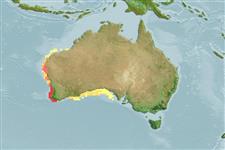Klassifizierung / Names
Namen | Synonyme | Catalog of Fishes(Gattung, Arten) | ITIS | CoL | WoRMS | Cloffa
>
Ophidiiformes (Cusk eels) >
Dinematichthyidae (Viviparous brotula)
Etymology: hutchinsi: Named for Barry Hutchins, Perth, WAM.
Eponymy: Dr J Barry Hutchins (d: 1946) was Curator of Fishes at the Western Australian Museum (1998–2007), which he joined as a Technical Officer (1972) and where he worked until he retired. [...] (Ref. 128868), visit book page.
More on authors: Møller & Schwarzhans.
Environment: milieu / climate zone / depth range / distribution range
Ökologie
seewasser riff-verbunden; tiefenbereich 10 - 60 m (Ref. 57886). Subtropical
Verbreitung
Länder | FAO Gebiete | Ecosystems | Vorkommen | Point map | Einführungen | Faunafri
Eastern Indian Ocean: Western Australia.
Size / Gewicht / Alter
Maturity: Lm ? range ? - ? cm
Max length : 10.2 cm SL Männchen/unbestimmt; (Ref. 57886); 11.8 cm SL (female)
Kurzbeschreibung
Bestimmungsschlüssel | Morphologie | Morphometrie
Rückenflossenweichstrahlen (insgesamt) : 104 - 110; Afterflossenweichstrahlen: 66 - 73; Wirbelzahl: 53 - 56. The species is characterized by having a very elongate body; vertebrae 16-17 + 36-40 = 53-56, dorsal fin rays 104-110, anal fin rays 66-73, D/A 41-43, V/A 19-20; scales present on body; no supraorbital pore behind eye; lower preopercular pores 3, non-tubular; posterior infraorbital pores 3; broad angle on ventral maxilla positioned behind rear of eye; exposed opercular
spine bent upwards; lower lip with skin folds; single pair of pseudoclaspers curved, hockey stick-like, thin; penis slightly shorter than pseudoclaspers, with hook at tip; otoliths pointed anteriorly and posteriorly, their predorsal and postdorsal angles are similar in expression, otolith length to height ratio 2.1-2.2, with sulcus narrow (Ref. 57886).
Life cycle and mating behavior
Geschlechtsreife | Fortpflanzung | Ablaichen | Eier | Fecundity | Larven
Møller, P.R. and W. Schwarzhans, 2006. Review of the Dinematichthyini (Teleostei, Bythitidae) of the Indo-west Pacific, Part II. Dermatopsis, Dermatopsoides and Dipulus with description of six new species. The Beagle 22:39-76. (Ref. 57886)
IUCN Rote Liste Status (Ref. 130435: Version 2024-2)
Bedrohung für Menschen
Harmless
Nutzung durch Menschen
Tools
Zusatzinformationen
Download XML
Internet Quellen
Estimates based on models
Preferred temperature (Ref.
123201): 16.8 - 22.6, mean 18 °C (based on 44 cells).
Phylogenetic diversity index (Ref.
82804): PD
50 = 0.6250 [Uniqueness, from 0.5 = low to 2.0 = high].
Bayesian length-weight: a=0.00389 (0.00180 - 0.00842), b=3.12 (2.94 - 3.30), in cm total length, based on all LWR estimates for this body shape (Ref.
93245).
Trophic level (Ref.
69278): 3.4 ±0.5 se; based on size and trophs of closest relatives
Fishing Vulnerability (Ref.
59153): Low vulnerability (10 of 100).
